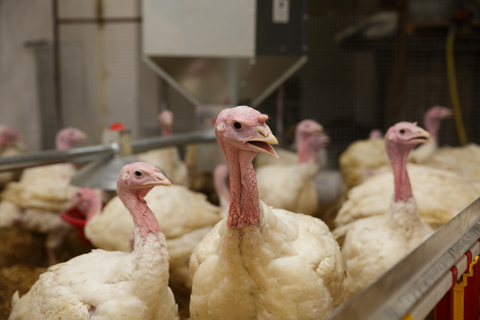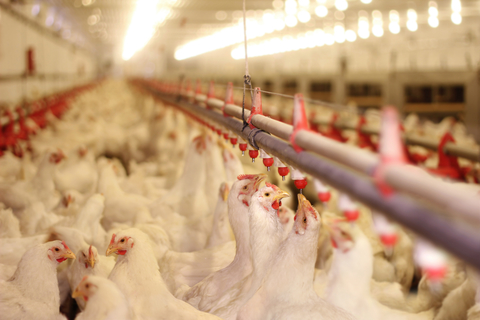Quick facts
- Birds are subject to heat stress when the air temperature and humidity uncontrollably increase their core body temperature.
- Heat stress can result in panting, increased water intake and eventually death.
- Access to cool, fresh water, ventilation, and adjusted feed schedules can help provide relief to birds.
When does heat stress occur?
Heat stress occurs when the bird’s core body temperature increases to fatal temperatures because of poor heat loss and limited coping means. Environmental temperature and humidity play a role in heat stress. Thus it is key to measure both the temperature and humidity in the barn.
See Heat Stress Indices for Livestock from Iowa State University for examples of temperature and humidity indexes.
Temperature
The thermoneutral zone is the range of environmental temperatures that an organism can maintain their body temperature. For most poultry, the thermoneutral zone is between 60 and 75 F. This zone represents the temperature range where heat production is lowest. As temperatures increase towards 85 F, the birds will adjust their behavior and decrease feed intake and production. These changes help prevent the bird’s core body temperature from increasing.
When air temperature increases towards 100 F, the birds’ core body temperatures will increase to lethal temperatures unless relief is provided.
These temperatures can shift depending on humidity, care and building conditions.
Humidity
High humidity decreases poultry heat loss from the lungs, which makes the birds more prone to heat stress. For older turkeys, temperatures at 85 F with humidity above 50 percent places turkeys in the danger zone. At 90 F and 50 percent humidity the risk increases to extreme.
If misting or fogging at low humidities, monitor relative humidity to prevent excess moisture in the air that can worsen heat stress conditions.
Signs of heat stress
As air temperatures increase towards 85 F, the bird will try to lose heat through evaporative cooling, panting. Panting creates more heat through muscle activity. As a result, the bird will increase its water intake, but not enough to keep up with the losses through respiration and urine excretion. Without relief, the changes will worsen and the bird may die.
Keeping birds cool
Providing ventilation
In most cases, you can manage heat in your flock through air flow. Airflow at the birds’ level is key to removing bird heat. Increasing ventilation to remove heat from the birds should be your first priority. However, some cases exist where ventilation is limiting.
Naturally-ventilated barns are at risk of heat stress if the air is calm and supplemental fans are not present. Mechanically-ventilated barns can also be at risk if barns lack ventilation capacity and air mixing for the size and number of birds present.
Feeding
Most often, birds are hungriest in the morning and will tend to fill up. This will make them more prone to heat stress in the afternoon. Withdrawing feed birds six hours before peak warm temperatures in the afternoon can lower the risk of heat stress.
You can reintroduce the feed after peak temperatures have started to decline. Birds can then feed during night time hours when we expect cooler temperatures to occur. Have the feeders full when lowering the feedline. You can use lighting during nighttime (midnight) feeding to allow intake.
You may notice some body weight loss depending on how often you use this feeding method. Thus only follow this feed method when you expect heat stress temperatures.
Managing water
During heat stress, birds will increase their water intake by 2 to 4 times their normal intake. Sufficient water space, operating waterers and cool water temperatures will encourage the birds to drink. Flush water lines and waterers routinely to keep the water fresh and cool.
Using electrolytes
You can add electrolytes to your flock’s drinking water for up to three days. Heat stress causes increased loss of several minerals including potassium, sodium, phosphorus, magnesium and zinc. Potassium chloride electrolytes appear to increase water intake when provided in drinking water at 0.6 percent concentration. It has been generally more effective than other potassium and sodium salts.
You should start providing electrolytes prior to the heat stress period.
Providing sodium bicarbonate
Sodium bicarbonate in the feed or use of carbonated water is especially useful for hens in egg production. Panting and carbon dioxide release can change the acid-base balance in poultry, but also the bicarbonate available for eggshell formation. Thus sodium bicarbonate can help lessen these changes.
Supplementing vitamins
Supplementing drinking water with vitamins (A, D, E and B complex) can be effective at tackling heat stress mortality in broilers. In breeding poultry, vitamin C can effectively moderate warm temperature declines in egg production and eggshell quality in laying hens, and sperm production in breeder males.
Other practices
Delay activity in the barn such as moving of birds or litter conditioning.
Provide shade for pastured poultry or decrease sun exposure in the barn.
Reviewed in 2022



